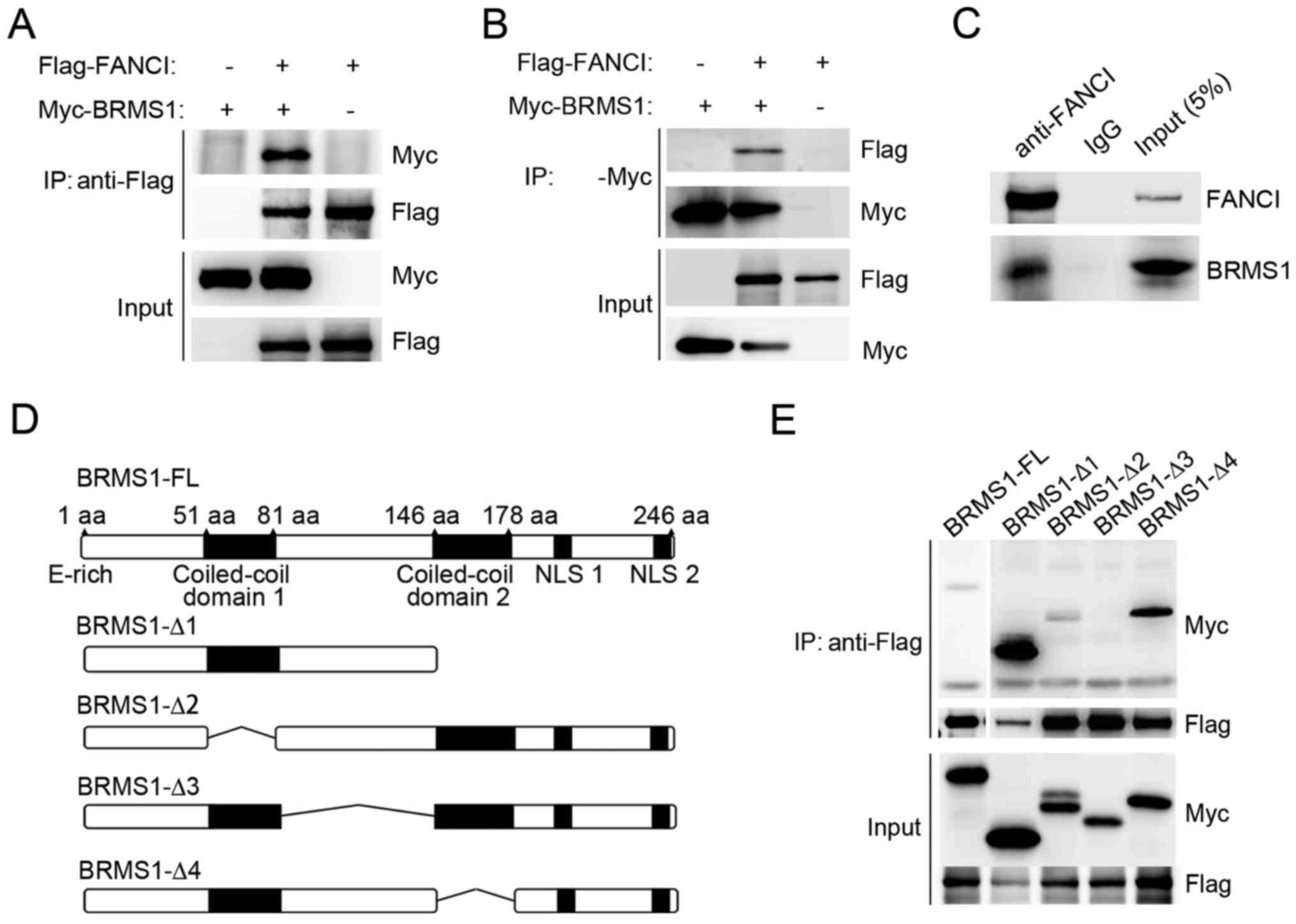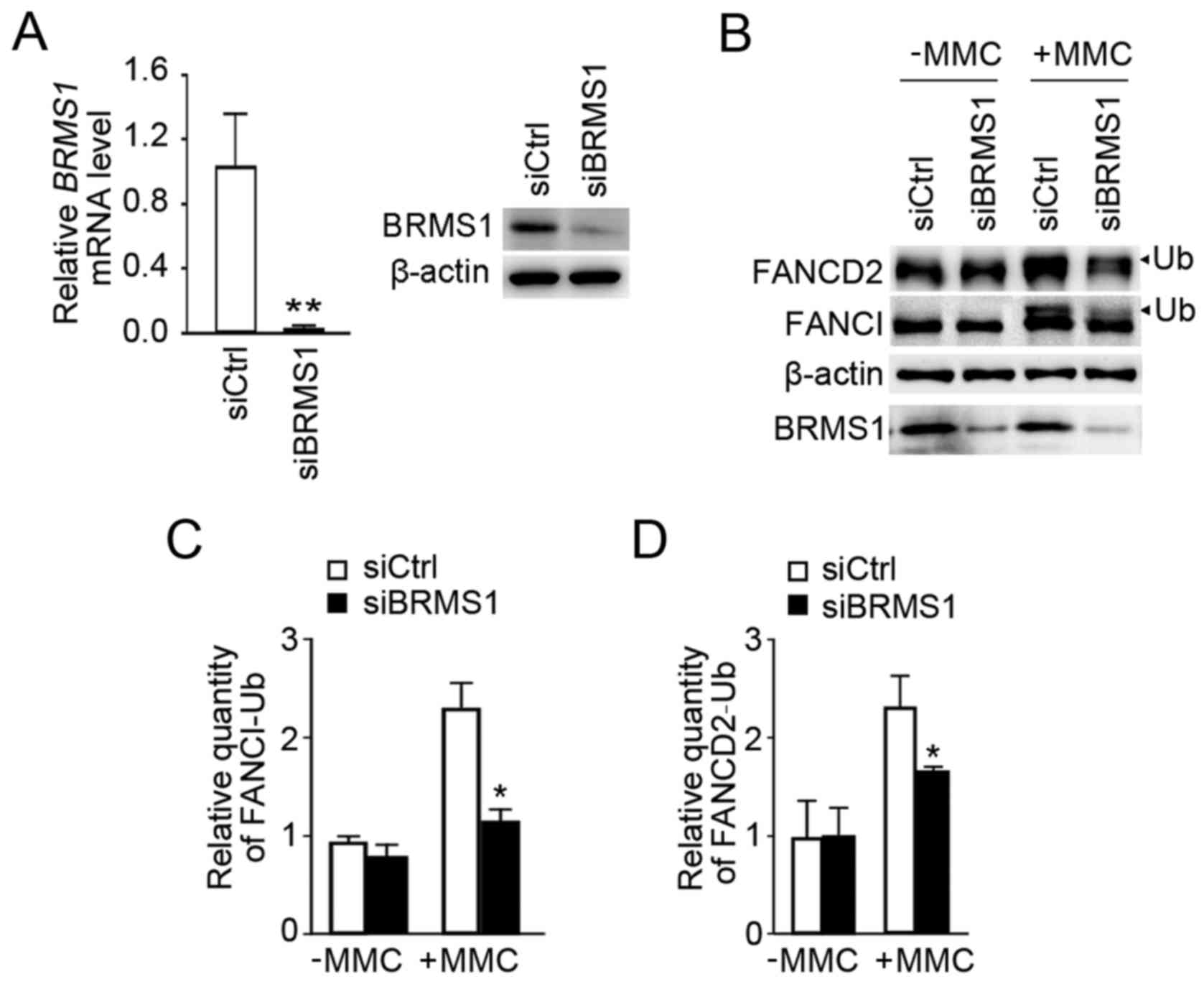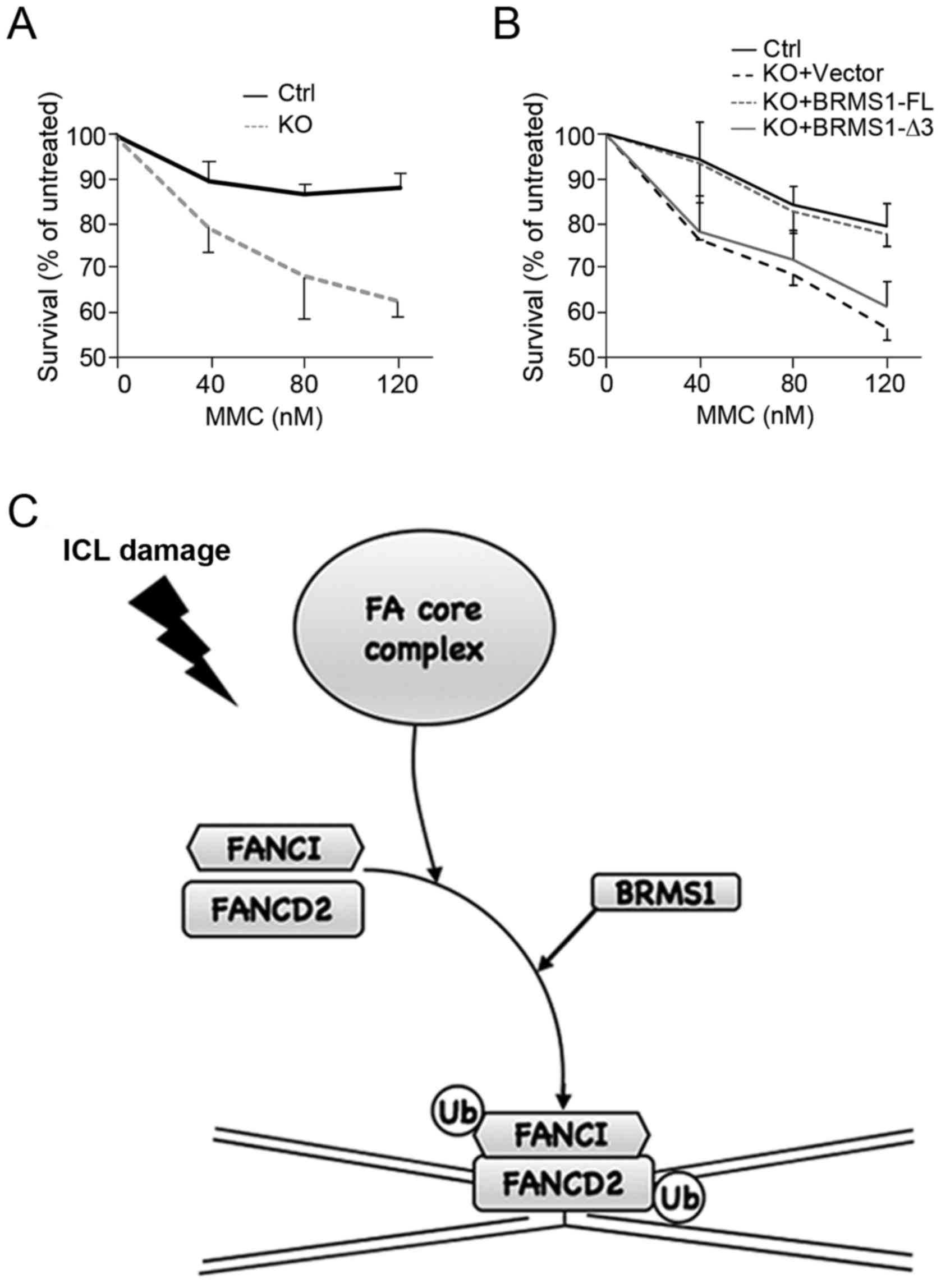|
1
|
Phillips KK, Welch DR, Miele ME, Lee JH,
Wei LL and Weissman BE: Suppression of MDA-MB-435 breast carcinoma
cell metastasis following the introduction of human chromosome 11.
Cancer Res. 56:1222–1227. 1996.PubMed/NCBI
|
|
2
|
Bodenstine TM, Vaidya KS, Ismail A, Beck
BH, Cook LM, Diers AR, Landar A and Welch DR: Homotypic gap
junctional communication associated with metastasis suppression
increases with PKA activity and is unaffected by PI3K inhibition.
Cancer Res. 70:10002–10011. 2010. View Article : Google Scholar : PubMed/NCBI
|
|
3
|
Shevde LA, Samant RS, Goldberg SF,
Sikaneta T, Alessandrini A, Donahue HJ, Mauger DT and Welch DR:
Suppression of human melanoma metastasis by the metastasis
suppressor gene, BRMS1. Exp Cell Res. 273:229–239. 2002. View Article : Google Scholar : PubMed/NCBI
|
|
4
|
Roesley SN, Suryadinata R, Morrish E, Tan
AR, Issa SM, Oakhill JS, Bernard O, Welch DR and Šarčević B:
Cyclin-dependent kinase-mediated phosphorylation of breast cancer
metastasis suppressor 1 (BRMS1) affects cell migration. Cell Cycle.
15:137–151. 2016. View Article : Google Scholar : PubMed/NCBI
|
|
5
|
Yang YL, Chen CZ, Jin LP, Ji QQ, Chen YZ,
Li Q, Zhang XH and Qu JM: Effect and mechanism of the metastasis
suppressor gene BRMS1 on the migration of breast cancer cells. Int
J Clin Exp Med. 6:908–916. 2013.PubMed/NCBI
|
|
6
|
Liu Y, Smith PW and Jones DR: Breast
cancer metastasis suppressor 1 functions as a corepressor by
enhancing histone deacetylase 1-mediated deacetylation of RelA/p65
and promoting apoptosis. Mol Cell Biol. 26:8683–8696. 2006.
View Article : Google Scholar : PubMed/NCBI
|
|
7
|
Wu Y, Jiang W, Wang Y, Wu J, Saiyin H,
Qiao X, Mei X, Guo B, Fang X, Zhang L, et al: Breast cancer
metastasis suppressor 1 regulates hepatocellular carcinoma cell
apoptosis via suppressing osteopontin expression. PLoS One.
7:e429762012. View Article : Google Scholar : PubMed/NCBI
|
|
8
|
Liu Y, Mayo MW, Xiao A, Hall EH, Amin EB,
Kadota K, Adusumilli PS and Jones DR: Loss of BRMS1 promotes a
mesenchymal phenotype through NF-κB-dependent regulation of Twist1.
Mol Cell Biol. 35:303–317. 2015. View Article : Google Scholar : PubMed/NCBI
|
|
9
|
Meehan WJ, Samant RS, Hopper JE, Carrozza
MJ, Shevde LA, Workman JL, Eckert KA, Verderame MF and Welch DR:
Breast cancer metastasis suppressor 1 (BRMS1) forms complexes with
retinoblastoma-binding protein 1 (RBP1) and the mSin3 histone
deacetylase complex and represses transcription. J Biol Chem.
279:1562–1569. 2004. View Article : Google Scholar : PubMed/NCBI
|
|
10
|
Liu Y, Amin EB, Mayo MW, Chudgar NP,
Bucciarelli PR, Kadota K, Adusumilli PS and Jones DR: CK2alpha'
drives lung cancer metastasis by targeting BRMS1 nuclear export and
degradation. Cancer Res. 76:2675–2686. 2016. View Article : Google Scholar : PubMed/NCBI
|
|
11
|
Liu Y, Mayo MW, Nagji AS, Hall EH, Shock
LS, Xiao A, Stelow EB and Jones DR: BRMS1 suppresses lung cancer
metastases through an E3 ligase function on histone
acetyltransferase p300. Cancer Res. 73:1308–1317. 2013. View Article : Google Scholar : PubMed/NCBI
|
|
12
|
Spinola-Amilibia M, Rivera J,
Ortiz-Lombardia M, Romero A, Neira JL and Bravo J: The structure of
BRMS1 nuclear export signal and SNX6 interacting region reveals a
hexamer formed by antiparallel coiled coils. J Mol Biol.
411:1114–1127. 2011. View Article : Google Scholar : PubMed/NCBI
|
|
13
|
Lobitz S and Velleuer E: Guido fanconi
(1892–1979): A jack of all trades. Nat Rev Cancer. 6:893–898. 2006.
View Article : Google Scholar : PubMed/NCBI
|
|
14
|
Auerbach AD: Fanconi anemia and its
diagnosis. Mutat Res. 668:4–10. 2009. View Article : Google Scholar : PubMed/NCBI
|
|
15
|
Stoepker C, Ameziane N, van der Lelij P,
Kooi IE, Oostra AB, Rooimans MA, van Mil SE, Brink A, Dietrich R,
Balk JA, et al: Defects in the Fanconi anemia pathway and chromatid
cohesion in head and neck cancer. Cancer Res. 75:3543–3553. 2015.
View Article : Google Scholar : PubMed/NCBI
|
|
16
|
Scharer OD: DNA interstrand crosslinks:
Natural and drug-induced DNA adducts that induce unique cellular
responses. Chembiochem. 6:27–32. 2005. View Article : Google Scholar : PubMed/NCBI
|
|
17
|
Ceccaldi R, Sarangi P and D'Andrea AD: The
Fanconi anaemia pathway: New players and new functions. Nat Rev Mol
Cell Biol. 17:337–349. 2016. View Article : Google Scholar : PubMed/NCBI
|
|
18
|
Sims AE, Spiteri E, Sims RJ III, Arita AG,
Lach FP, Landers T, Wurm M, Freund M, Neveling K, Hanenberg H, et
al: FANCI is a second monoubiquitinated member of the Fanconi
anemia pathway. Nat Struct Mol Biol. 14:564–567. 2007. View Article : Google Scholar : PubMed/NCBI
|
|
19
|
Castella M, Jacquemont C, Thompson EL, Yeo
JE, Cheung RS, Huang JW, Sobeck A, Hendrickson EA and Taniguchi T:
FANCI regulates recruitment of the FA core complex at sites of DNA
damage independently of FANCD2. PLoS Genet. 11:e10055632015.
View Article : Google Scholar : PubMed/NCBI
|
|
20
|
Liu X, Ehmed E, Li B, Dou J, Qiao X, Jiang
W, Yang X, Qiao S and Wu Y: Breast cancer metastasis suppressor 1
modulates SIRT1-dependent p53 deacetylation through interacting
with DBC1. Am J Cancer Res. 6:1441–1449. 2016.PubMed/NCBI
|
|
21
|
Livak KJ and Schmittgen TD: Analysis of
relative gene expression data using real-time quantitative PCR and
the 2−ΔΔCT method. Methods. 25:402–408. 2001. View Article : Google Scholar : PubMed/NCBI
|
|
22
|
Shimamura A and Alter BP: Pathophysiology
and management of inherited bone marrow failure syndromes. Blood
Rev. 24:101–122. 2010. View Article : Google Scholar : PubMed/NCBI
|
|
23
|
Williams SA, Longerich S, Sung P, Vaziri C
and Kupfer GM: The E3 ubiquitin ligase RAD18 regulates
ubiquitylation and chromatin loading of FANCD2 and FANCI. Blood.
117:5078–5087. 2011. View Article : Google Scholar : PubMed/NCBI
|
|
24
|
Oka Y, Bekker-Jensen S and Mailand N:
Ubiquitin-like protein UBL5 promotes the functional integrity of
the Fanconi anemia pathway. EMBO J. 34:1385–1398. 2015. View Article : Google Scholar : PubMed/NCBI
|
|
25
|
Dorsman JC, Levitus M, Rockx D, Rooimans
MA, Oostra AB, Haitjema A, Bakker ST, Steltenpool J, Schuler D,
Mohan S, et al: Identification of the Fanconi anemia
complementation group I gene, FANCI. Cell Oncol. 29:211–218.
2007.PubMed/NCBI
|
|
26
|
Smogorzewska A, Matsuoka S, Vinciguerra P,
McDonald ER III, Hurov KE, Luo J, Ballif BA, Gygi SP, Hofmann K,
D'Andrea AD, et al: Identification of the FANCI protein, a
monoubiquitinated FANCD2 paralog required for DNA repair. Cell.
129:289–301. 2007. View Article : Google Scholar : PubMed/NCBI
|
|
27
|
Tutt A, Gabriel A, Bertwistle D, Connor F,
Paterson H, Peacock J, Ross G and Ashworth A: Absence of Brca2
causes genome instability by chromosome breakage and loss
associated with centrosome amplification. Curr Biol. 9:1107–1110.
1999. View Article : Google Scholar : PubMed/NCBI
|
|
28
|
Zhang Q, McCorkle JR, Novak M, Yang M and
Kaetzel DM: Metastasis suppressor function of NM23-H1 requires its
3′-5′exonuclease activity. Int J Cancer. 128:40–50. 2011.
View Article : Google Scholar : PubMed/NCBI
|
|
29
|
Castro E, Goh C, Olmos D, Saunders E,
Leongamornlert D, Tymrakiewicz M, Mahmud N, Dadaev T, Govindasami
K, Guy M, et al: Germline BRCA mutations are associated with higher
risk of nodal involvement, distant metastasis, and poor survival
outcomes in prostate cancer. J Clin Oncol. 31:1748–1757. 2013.
View Article : Google Scholar : PubMed/NCBI
|
|
30
|
Yu DS, Sonoda E, Takeda S, Huang CL,
Pellegrini L, Blundell TL and Venkitaraman AR: Dynamic control of
Rad51 recombinase by self-association and interaction with BRCA2.
Mol Cell. 12:1029–1041. 2003. View Article : Google Scholar : PubMed/NCBI
|
|
31
|
Ree AH, Bratland A, Nome RV, Stokke T and
Fodstad Ø: Repression of mRNA for the PLK cell cycle gene after DNA
damage requires BRCA1. Oncogene. 22:8952–8955. 2003. View Article : Google Scholar : PubMed/NCBI
|
|
32
|
Balacescu O, Balacescu L, Tudoran O, Todor
N, Rus M, Buiga R, Susman S, Fetica B, Pop L, Maja L, et al: Gene
expression profiling reveals activation of the FA/BRCA pathway in
advanced squamous cervical cancer with intrinsic resistance and
therapy failure. BMC Cancer. 14:2462014. View Article : Google Scholar : PubMed/NCBI
|













